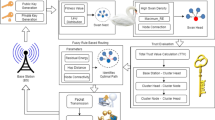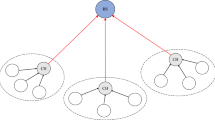Abstract
For the problems of traditional overburden hole detection methods, such as overtime, low accuracy and high running cost, etc. A multi factor reliable coverage hole detection method based on LEACH algorithm is proposed. Based on the analysis of the QoS architecture of wireless sensor networks and the research of representative network layer symmetry protocols, a symmetric network model is constructed according to the selection of gateway performance parameters, gateway selection criterion function and symmetry criterion, and a symmetric criterion design and optimization strategy is given. It uses this strategy to improve LEACH algorithm in three aspects. Two reliability optimization factors are added to the similarity calculation of coverage hole detection, which are node intrusion optimization factor and multipath transmission optimization factor respectively. Multipath transmission optimization factor is used in data transmission. In hostile environments, in order to avoid a large number of malicious nodes interfering with real data, the data containing noise should be filtered and processed. Then, the similarity is calculated by multi-path transmission optimization factor, and the coverage holes of wireless sensor networks are detected by weighted average. The experimental results show that the proposed method takes less time to detect the covering holes, which has higher detection accuracy and lower operation cost.






Similar content being viewed by others
Data Availability
There is no data file included in this work.
Code Availability
There is no specific code in this work specified.
References
Wang, L. M., Li, F. & Qin, Y. (2016). An overlay hole repair method for wireless sensor networks based on mobile nodes. Journal of Communications, 32(4), 1–8.
Dong, X. M. & Yang, J. (2016). A wormhole attack detection algorithm in wireless sensor networks. Journal of Northeast University (Natural Science Edition), 33(9), 1253–1256.
Wang, X. W. & Lu, K. (2017). Coverage hole detection based on geometric method in wireless sensor networks. Journal of Hubei University of Automotive Technology, 28(1), 59–62.
Han, R., Zhang, S. K. & Chen, P. F. (2016). Random walk based covering hole repair for wireless sensor networks. Computer Applications and Software, 33(8), 141–145.
Yu, X. W., Zhang, F., Zhou, L. X. et al. (2017). Hierarchical data fusion of event-driven and trust-allocation weighting in WSN. Journal of Transducer Technology, 30(12), 1948–1953.
Huang, T. H., Yi, K., Wang, Y. L. et al. (2016). Firefly algorithm optimization neural network wireless sensor network data fusion. Instrumentation Technology and Sensors, 2(7), 103–107.
Lin, J., Zuluaga, S., Yu, P. et al. (2017). A novel PD2Se3 two-dimensional phase driven by interlayer fusion in layered PDSe2. Physical Review Letters, 119(1), 1700–1701.
Yang, H. (2017). Blind area detection in wireless sensor networks based on improved distributed algorithm. Neijiang Science and Technology, 38(4), 43–43.
Gao, W. & Wang, W. (2017). New isolated toughness condition for fractional (G, F, N) - critical graph. Colloquium Mathematicum, 147(1), 55–65.
Bardsiri, A. K. (2018). A new combinatorial framework for software services development effort estimation. International Journal of Computers and Applications, 40(1), 14–24.
Zhu, Z. W., Wang, J., Wang, L. et al. (2017). Detection and localization of wormhole attacks in wireless sensor networks. Computer Technology and Development, 27(4), 120–125.
Azis, N. A., Jeong, Y. S., Choi, H. J. et al. (2016). Weighted averaging fusion for multi-view skeletal data and its application in action recognition. IET Computer Vision, 10(2), 134–142.
Hirano, M., Tsuzuki, N., Ikeda, S. et al. (2018) Logdrive: A proactive data collection and analysis framework for time-traveling forensic investigation in iaas cloud environments. Journal of Cloud Computing,7(1).
Kalirajan, K., Sudha, M. (2017). Moving object detection using median-based scale invariant local ternary pattern for video surveillance system. Journal of Intelligent and Fuzzy Systems, 33(3), 1933–1943.
Wu, X. H., Song, S. M. (2017). Covariance Intersection-Based Fusion Algorithm for Asynchronous Multirate Multisensor System with Cross-Correlation. IET Science Measurement & Technology, 11(7), 878–885.
Yang, Y., Zhong, M., Yao, H. et al. (2018). Internet of things for smart ports: technologies and challenges. IEEE Instrumentation & Measurement Magazine, 21(1), 34–43.
Lokesha, V., Deepika, T., Ranjini, P. S., et al. (2017). Operations of nanostructures via Sdd, Abc4 and Ga5 Indices. Applied Mathematics & Nonlinear Sciences, 2(1), 173–180.
Li, X., Wang, L., Wang, J. et al. (2017). Multi-focus image fusion algorithm based on multilevel morphological component analysis and support vector machine. Iet Image Processing, 11(10), 919–926.
Rong, D. S., Hu, J. S., Zhao, J. J. et al. (2018). Based on data fusion Iga-Rgrnn low-rank coal methane production prediction model. Journal of Power Supply, 16(1), 178–184.
Tan, X. F., Xuan, T. T. & Zhang, P. C. (2016). Non-intrusive load identification and classification based on data flow. Chinese Journal of Power Sources, 40(5), 1110–1112.
Zhou, X. L. & Zhang, H. (2017). Research on periodic bit data analysis model based on time characteristics. Journal of China Academy of Electronics and Information Technology, 12(2), 128–131.
Zhu, Y. (2017). Data fusion algorithm for wireless sensor networks based on deep learning. Automation & Instrumentation, 9, 28–29.
Udendhran, R., Balamurgan, M. Suresh, A., and Varatharajan R. (2020) Enhancing image processing architecture using deep learning for embedded vision systems. Microprocessors and Microsystems.
R.Geetha, Dr.S.Sivasubramanian, Dr.M.Kaliappan, S.Vimal, and Dr.A.Suresh (2019) Cervical cancer identification with synthetic minority oversampling technique and PCA Analysis using Random Forest Classifier. Journal of Medical Systems.
U.Ramani, R.Nithya, M.Thilagaraj, S.Sathiesh Kumar (2020) Genetic Algorithm Based Three Input DC Source Using Hybrid Power System. Journal of Green Engineering Vol 10, No 7, pp 4227–4243.
R.Krishna Kumar, S.Diwakaran, M.Thilagaraj (2020) Reactive Power Control of Modern Type High Effective Phase Grid-Tied Photovoltaic Network Inverter. Journal of Green Engineering, Vol 10, No 9, pp 4874–4884, 2020.
Funding
This research is supported by Henan Science and Technology Research Project: Research on Intelligent Family Health Service System Based on Mobile Internet Technology, 172102210118.
Author information
Authors and Affiliations
Corresponding author
Ethics declarations
Conflict of interest
There is no conflict of interest.
Additional information
Publisher's Note
Springer Nature remains neutral with regard to jurisdictional claims in published maps and institutional affiliations.
Rights and permissions
About this article
Cite this article
Wang, F., Hu, H. Symmetric Algorithm for Detection of Coverage Hole in Wireless Sensor Network. Wireless Pers Commun 127, 141–158 (2022). https://doi.org/10.1007/s11277-021-08097-9
Accepted:
Published:
Issue Date:
DOI: https://doi.org/10.1007/s11277-021-08097-9




